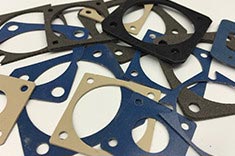EMI Shielding Products
- Custom Gasket Fabrication
- Connector Gaskets
- Bonded O Ring
- Custom Gaskets
- Conduct-O-Knit Knitted Wire Mesh
- Conduct-O-Seal Combo Gasket
- Conduct-O-Elastomer
- Conduct-O-Seal Oriented Wire in Silicone Gasket Material
- Conduct-O-Mesh Tape
- Conduct-O-Foam
- Conduct-O-Bond
- Optical Filters For Electronic Displays
- Shielded Vent Panels
- ESC Board Level Shielding
- 300 Series
Understanding EMI Shielding: A Guide to Functional and Structural Approaches
 Electromagnetic interference (EMI) shielding is crucial for safeguarding electronic devices from harmful microwave and radio wave radiation. It ensures that these devices can function without disruption from external electromagnetic fields, maintaining their integrity and performance in a world increasingly saturated with electronic signals and noise. This understanding sets the stage for exploring the advanced strategies employed in functional and structural EMI shielding, each tailored to specific applications and challenges in electronics and beyond.
Electromagnetic interference (EMI) shielding is crucial for safeguarding electronic devices from harmful microwave and radio wave radiation. It ensures that these devices can function without disruption from external electromagnetic fields, maintaining their integrity and performance in a world increasingly saturated with electronic signals and noise. This understanding sets the stage for exploring the advanced strategies employed in functional and structural EMI shielding, each tailored to specific applications and challenges in electronics and beyond.
Functional vs. Structural EMI Shields: What's the Difference?
Functional EMI Shields
In the digital age, functional EMI shields are a critical defense mechanism seamlessly integrated into the fabric of electronic devices such as mobile phones. These shields are meticulously engineered to curtail electromagnetic radiation, leveraging advanced materials like graphene to ensure efficacy. Essential for devices operating within the dynamic realms of radio and microwave frequencies, functional EMI shields are the unsung heroes that maintain device integrity and performance amidst a sea of electromagnetic noise.
- Designed for integration into devices like mobile phones.
- Focus on minimizing electromagnetic radiation.
- Utilize materials such as graphene for effective shielding.
- Essential for devices operating at radio and microwave frequencies.
Structural EMI Shields
Structural EMI shields embody electromagnetic protection and structural fortitude, catering to sectors where resilience meets technological safeguarding, such as aerospace and civil engineering. These shields employ robust materials like carbon-fiber composites, offering durability and a shield against electromagnetic intrusions. Ideal for safeguarding large infrastructures, they provide a bulwark against electromagnetic pulses (EMPs) and ensure privacy, encapsulating a dual-purpose solution in the modern architectural and engineering landscape.
- Serve dual purposes: electromagnetic shielding and structural support.
- Used in applications requiring strength and protection, like aerospace or civil engineering.
- Materials include carbon-fiber composites, offering durability and shielding.
- Suitable for large infrastructures, providing EMP protection and privacy.
Choosing the Right Shield
The selection between functional and structural EMI shields depends on the application's requirements. Factors such as load-bearing capacity, device size, and shielding efficiency are critical in determining the most suitable shielding strategy.
Both functional and structural EMI shields are essential in protecting against electromagnetic interference. As technology advances, the development of innovative materials and design strategies will continue to enhance the effectiveness of EMI shielding solutions.



